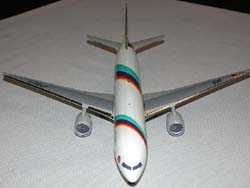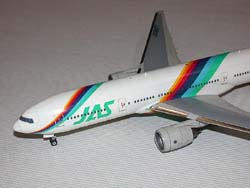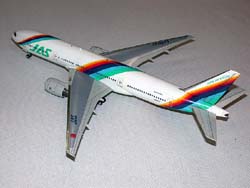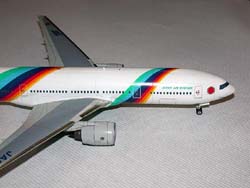Japan Air Systems Boeing 777
|  | Introduction The 777 is Boeing's latest all-new airliner. Let's hope it's not the last! The 777 evolved out of "767-X" studies for a 767 replacement in the late 1980s. An unprecedented degree of customer discussions led to a significantly larger airplane which was launched as the 777 in October, 1990. The 777 design took advantage of advances in aerodynamics, structures, materials, avionics, and flight control technology. First flight of the initial 777-200 took place out of Paine Field in Everett, WA on June 12, 1994. Since initial delivery to United in May, 1995, the extended range 777-200ER, and the stretched 777-300 have been introduced. The longer range 777-300ER is currently in flight test, and the ultra long range 777-200LR is in development.  Japan Air Systems is not well known in the U.S., but it is a major player in the Japanese domestic market. Formerly known as Toa Domestic Airlines, the carrier was formed in May 1971 by the merger of Japan Domestic Airlines and Toa Airways. In 2002, the merger of JAS with the larger Japan Air Lines (JAL) was announced. Japan Air Systems is not well known in the U.S., but it is a major player in the Japanese domestic market. Formerly known as Toa Domestic Airlines, the carrier was formed in May 1971 by the merger of Japan Domestic Airlines and Toa Airways. In 2002, the merger of JAS with the larger Japan Air Lines (JAL) was announced.
JAS had a large McDonnell-Douglas MD-80 series fleet, but wished to expand their ability to carry large passenger loads on their major routes in the mid-1990s. They became one of the launch customers for the 777 and took their first delivery of the type in 1996. The JAS 777s bear a spectacular "Rainbow" livery which resulted from a children's competition. The Build  The Hasegawa 1/200 777-200 kit was first released in Japan Air Lines (JAL) markings in 1997, with Pratt & Whitney engines. Other major 777 customers and engine types followed. My favorite 777 livery is the JAS "Rainbow 777", a decal sheet for which has only been offered by Hasegawa in a kit for the Japanese home market. I found one at Hobbylink Japan. The Hasegawa 1/200 777-200 kit was first released in Japan Air Lines (JAL) markings in 1997, with Pratt & Whitney engines. Other major 777 customers and engine types followed. My favorite 777 livery is the JAS "Rainbow 777", a decal sheet for which has only been offered by Hasegawa in a kit for the Japanese home market. I found one at Hobbylink Japan.
The Hasegawa kit comes in six sprues, not including the clear canopy window part and the display stand. Two of the sprues are carbon copies of each other, providing the necessary duplicate engine nacelle, landing gear, and flap track fairing parts. Overall accuracy and detail is decent for this scale – for example, the right side of the rudder replicates the three rudder tab rod fairings that were missing from the mediocre (and very expensive) Doyusha 1/144 777.  The model has recessed panel lines, but their quality is not up to usual Hasegawa standards. The fuselage panel lines go soft in places. The wing surfaces have a few odd, extraneous line segments – they look much like what you might achieve yourself if you daydream while scribing your own lines. The model has recessed panel lines, but their quality is not up to usual Hasegawa standards. The fuselage panel lines go soft in places. The wing surfaces have a few odd, extraneous line segments – they look much like what you might achieve yourself if you daydream while scribing your own lines.
Assembly is pretty straightforward, with bugaboos in two areas. The fuselage join (don'’t forget to install the included screw as nose ballast!) is uneven and requires a fair amount of scraping, filling, and sanding to make smooth. Care is needed here to avoid flat spotting parts of the upper fuselage. The other, traditional, problem area is the joining of the engine nacelle halves. Anyone who has built jet airliners is familiar with the problem of dealing with the internal seams in the inlet. (Minicraft solves this problem by the design of the nacelle parts in their 1/144 777 kit.) My 'solution' was to finish the fan blade disk (paint, gloss, wash, dry brush, apply spinner decal, then semi-gloss), then cover it with liquid mask. After assembly of the nacelle, I then did my best to address the seams and paint the nacelle before removing the fan blade mask. A good idea, but removing the fan blade mask proved more difficult than expected, and caused some rework due to ham-handedness. The final result was OK fan blades and still a hint of seam lines in the inlet. Oh, well!  The landing gear lack much detail, a common trait of kits in this scale. Wheels and tires are acceptable, but the main landing gear wheel hub detail is crisper on some wheels than others. The wheel wells have no detail, again expected for airliners in this scale. The landing gear lack much detail, a common trait of kits in this scale. Wheels and tires are acceptable, but the main landing gear wheel hub detail is crisper on some wheels than others. The wheel wells have no detail, again expected for airliners in this scale.
Wing trailing edges are thick, and I did my best to thin them to something close to a scale look. Painting and Finishing  The fuselage is all white, and I tend to use Testors Model Master flat white for all work in white. After sanding smooth, I hit it with Duracryl automotive gloss lacquer. The wings were done in light gull gray, with a darker neutral gray applied between the spars. Horizontal tail is light gull gray. Nothing too fancy here. The fuselage is all white, and I tend to use Testors Model Master flat white for all work in white. After sanding smooth, I hit it with Duracryl automotive gloss lacquer. The wings were done in light gull gray, with a darker neutral gray applied between the spars. Horizontal tail is light gull gray. Nothing too fancy here.
 I used Alclad II "Polished Aluminum" on the engine inlets, and Bare Metal Foil "Matte Aluminum" on the leading edge slats, and horizontal and vertical tail leading edges. I goofed on the vertical tail – the polished metal leading edge is a very small percentage of the chord. I didn't even consider the leading edge treatment until after application of the tricky decals (described below). At that point, I was only willing to risk trimming the foil in the nearest panel line, which is well aft of the leading edge. My vertical fin bare metal treatment is therefore at least twice as large as it should be. I used Alclad II "Polished Aluminum" on the engine inlets, and Bare Metal Foil "Matte Aluminum" on the leading edge slats, and horizontal and vertical tail leading edges. I goofed on the vertical tail – the polished metal leading edge is a very small percentage of the chord. I didn't even consider the leading edge treatment until after application of the tricky decals (described below). At that point, I was only willing to risk trimming the foil in the nearest panel line, which is well aft of the leading edge. My vertical fin bare metal treatment is therefore at least twice as large as it should be.
I gave the engine tail cones a spray of Testors burnt iron lightened with silver.  Airliners are often represented as pristine, factory fresh vehicles. Cursory inspection of these working birds at an airport reveals they do collect dirt. They are not covered in filth, of course, but they do show signs of being used! With this in mind, after the Duracryl treatment, I applied a medium gray wash to the flight control surfaces and flaps, and a light gray treatment to the panel lines. The landing gear were also subjected to a light gray/brown wash. I probably overdid it, but I do think some degree of light weathering is appropriate for airliners. Airliners are often represented as pristine, factory fresh vehicles. Cursory inspection of these working birds at an airport reveals they do collect dirt. They are not covered in filth, of course, but they do show signs of being used! With this in mind, after the Duracryl treatment, I applied a medium gray wash to the flight control surfaces and flaps, and a light gray treatment to the panel lines. The landing gear were also subjected to a light gray/brown wash. I probably overdid it, but I do think some degree of light weathering is appropriate for airliners.
I used Kristal Kleer to dress up the various light lenses. Decals Now we get to the heart of the matter. What separates this 777-200 kit from the other Hasegawa 777 offerings is the JAS decal sheet. The rainbow stripe is represented by several decal segments, which must conform to the complex curvature of the fuselage as it spirals from one end of the airplane to the other. The Hasegawa instruction sheet innocently states: "When applying the rainbow strip decal, make sure you use warm water to make the decal easy to handle, and take your time to make sure it is in the proper location. In some locations, the flat decal will form wrinkles on the aircraft'’s fuselage. Press these flat using a soft cloth or tissue for the best appearance." Allrighty then!  The rainbow stripes were a fiasco. I started with the tail to anchor the placement, and worked forward. Copious amounts of Microsol and/or Solvaset, X-Acto incisions, and more Microsol and/or Solvaset were ineffective at eliminating all the wrinkles. I resorted to spraying the model with Duracryl gloss, then lightly sanding away the wrinkles. This approach naturally requires paint touchup to restore the color that was sanded away. If you have ever tried mixing paints to match decal colors, you have my sympathy. My efforts were mostly successful for the darker shades of the rainbow, but poor for the yellow, orange, and especially the "teal" shade. Most of this ugliness was confined to the lower fuselage, thankfully, but the vertical tail also suffers upon close inspection. The rainbow stripes were a fiasco. I started with the tail to anchor the placement, and worked forward. Copious amounts of Microsol and/or Solvaset, X-Acto incisions, and more Microsol and/or Solvaset were ineffective at eliminating all the wrinkles. I resorted to spraying the model with Duracryl gloss, then lightly sanding away the wrinkles. This approach naturally requires paint touchup to restore the color that was sanded away. If you have ever tried mixing paints to match decal colors, you have my sympathy. My efforts were mostly successful for the darker shades of the rainbow, but poor for the yellow, orange, and especially the "teal" shade. Most of this ugliness was confined to the lower fuselage, thankfully, but the vertical tail also suffers upon close inspection.
The remaining decals were completely conventional and were applied with no problem. Conclusion The Hasegawa 1/200 777 is a decent kit and can be made into a fine representation of Boeing's best. If you are interested in doing one for yourself, consider buying two kits just to get a spare decal set. With JAS merging with JAL, the future of the JAS Rainbow livery may be in doubt. I hope JAL sees fit to retain these spectacular rainbow birds in their fleet. Maybe Hasegawa can now move on to tackle the new 777-300ER with the spectacular Boeing company scheme. Those decals should be no sweat! References -
"Boeing 777", by Jim Upton, Airliner Tech Series Vol. 2, Specialty Press Publishers and Wholesalers -
"Boeing 777, Jetliner for a New Century", by Philip Birtles, Airliner Color History, MBI Publishing Company -
"Boeing 777", by Guy Norris & Mark Wagner, Enthusiast Color Series, Motorbooks International -
"""Twenty-First Century Jet, The Making and Marketing of the Boeing 777", by Karl Sabbagh, Scribner [Companion to the PBS television series of the same name, and the best history of the 777 program] -
Airliners.net [Probably the best site on the web for airliner photography] | 








|

 Japan Air Systems is not well known in the U.S., but it is a major player in the Japanese domestic market. Formerly known as Toa Domestic Airlines, the carrier was formed in May 1971 by the merger of Japan Domestic Airlines and Toa Airways. In 2002, the merger of JAS with the larger Japan Air Lines (JAL) was announced.
Japan Air Systems is not well known in the U.S., but it is a major player in the Japanese domestic market. Formerly known as Toa Domestic Airlines, the carrier was formed in May 1971 by the merger of Japan Domestic Airlines and Toa Airways. In 2002, the merger of JAS with the larger Japan Air Lines (JAL) was announced. The Hasegawa 1/200 777-200 kit was first released in Japan Air Lines (JAL) markings in 1997, with Pratt & Whitney engines. Other major 777 customers and engine types followed. My favorite 777 livery is the JAS "Rainbow 777", a decal sheet for which has only been offered by Hasegawa in a kit for the Japanese home market. I found one at Hobbylink Japan.
The Hasegawa 1/200 777-200 kit was first released in Japan Air Lines (JAL) markings in 1997, with Pratt & Whitney engines. Other major 777 customers and engine types followed. My favorite 777 livery is the JAS "Rainbow 777", a decal sheet for which has only been offered by Hasegawa in a kit for the Japanese home market. I found one at Hobbylink Japan. The model has recessed panel lines, but their quality is not up to usual Hasegawa standards. The fuselage panel lines go soft in places. The wing surfaces have a few odd, extraneous line segments – they look much like what you might achieve yourself if you daydream while scribing your own lines.
The model has recessed panel lines, but their quality is not up to usual Hasegawa standards. The fuselage panel lines go soft in places. The wing surfaces have a few odd, extraneous line segments – they look much like what you might achieve yourself if you daydream while scribing your own lines. The landing gear lack much detail, a common trait of kits in this scale. Wheels and tires are acceptable, but the main landing gear wheel hub detail is crisper on some wheels than others. The wheel wells have no detail, again expected for airliners in this scale.
The landing gear lack much detail, a common trait of kits in this scale. Wheels and tires are acceptable, but the main landing gear wheel hub detail is crisper on some wheels than others. The wheel wells have no detail, again expected for airliners in this scale. The fuselage is all white, and I tend to use Testors Model Master flat white for all work in white. After sanding smooth, I hit it with Duracryl automotive gloss lacquer. The wings were done in light gull gray, with a darker neutral gray applied between the spars. Horizontal tail is light gull gray. Nothing too fancy here.
The fuselage is all white, and I tend to use Testors Model Master flat white for all work in white. After sanding smooth, I hit it with Duracryl automotive gloss lacquer. The wings were done in light gull gray, with a darker neutral gray applied between the spars. Horizontal tail is light gull gray. Nothing too fancy here. I used Alclad II "Polished Aluminum" on the engine inlets, and Bare Metal Foil "Matte Aluminum" on the leading edge slats, and horizontal and vertical tail leading edges. I goofed on the vertical tail – the polished metal leading edge is a very small percentage of the chord. I didn't even consider the leading edge treatment until after application of the tricky decals (described below). At that point, I was only willing to risk trimming the foil in the nearest panel line, which is well aft of the leading edge. My vertical fin bare metal treatment is therefore at least twice as large as it should be.
I used Alclad II "Polished Aluminum" on the engine inlets, and Bare Metal Foil "Matte Aluminum" on the leading edge slats, and horizontal and vertical tail leading edges. I goofed on the vertical tail – the polished metal leading edge is a very small percentage of the chord. I didn't even consider the leading edge treatment until after application of the tricky decals (described below). At that point, I was only willing to risk trimming the foil in the nearest panel line, which is well aft of the leading edge. My vertical fin bare metal treatment is therefore at least twice as large as it should be. Airliners are often represented as pristine, factory fresh vehicles. Cursory inspection of these working birds at an airport reveals they do collect dirt. They are not covered in filth, of course, but they do show signs of being used! With this in mind, after the Duracryl treatment, I applied a medium gray wash to the flight control surfaces and flaps, and a light gray treatment to the panel lines. The landing gear were also subjected to a light gray/brown wash. I probably overdid it, but I do think some degree of light weathering is appropriate for airliners.
Airliners are often represented as pristine, factory fresh vehicles. Cursory inspection of these working birds at an airport reveals they do collect dirt. They are not covered in filth, of course, but they do show signs of being used! With this in mind, after the Duracryl treatment, I applied a medium gray wash to the flight control surfaces and flaps, and a light gray treatment to the panel lines. The landing gear were also subjected to a light gray/brown wash. I probably overdid it, but I do think some degree of light weathering is appropriate for airliners. The rainbow stripes were a fiasco. I started with the tail to anchor the placement, and worked forward. Copious amounts of Microsol and/or Solvaset, X-Acto incisions, and more Microsol and/or Solvaset were ineffective at eliminating all the wrinkles. I resorted to spraying the model with Duracryl gloss, then lightly sanding away the wrinkles. This approach naturally requires paint touchup to restore the color that was sanded away. If you have ever tried mixing paints to match decal colors, you have my sympathy. My efforts were mostly successful for the darker shades of the rainbow, but poor for the yellow, orange, and especially the "teal" shade. Most of this ugliness was confined to the lower fuselage, thankfully, but the vertical tail also suffers upon close inspection.
The rainbow stripes were a fiasco. I started with the tail to anchor the placement, and worked forward. Copious amounts of Microsol and/or Solvaset, X-Acto incisions, and more Microsol and/or Solvaset were ineffective at eliminating all the wrinkles. I resorted to spraying the model with Duracryl gloss, then lightly sanding away the wrinkles. This approach naturally requires paint touchup to restore the color that was sanded away. If you have ever tried mixing paints to match decal colors, you have my sympathy. My efforts were mostly successful for the darker shades of the rainbow, but poor for the yellow, orange, and especially the "teal" shade. Most of this ugliness was confined to the lower fuselage, thankfully, but the vertical tail also suffers upon close inspection.







